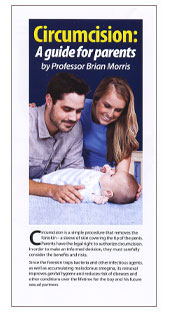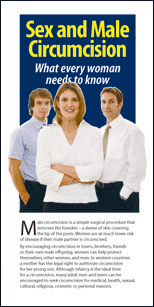Cervical Cancer in Female Partners of
Uncircumcised Men
Two systematic reviews of all studies found that male circumcision provides protection against high-risk HPV and cervical cancer [Grund et al., 2017; Morris et al., 2019b]. Below is background and information on some of the research findings over the years on this topic.
In the USA there are 12,000 new cases and 4,000 deaths from cervical cancer each year [Centers, 2006]. Treatment of each case costs $20,000 to $40,000 (American Cancer Society figures). This works out at a total of $24 to $48 million. Then there is the social cost and devastation to individuals and families.
A number of studies have documented higher rates of cervical cancer in women who have had one or more male sexual partners who were uncircumcised. Whereas the earlier studies were somewhat equivocal the evidence from a large international study published in 2002 in the New England Journal of Medicine, to be discussed later, provided overwhelming evidence of the link between lack of male circumcision and cervical cancer in the female sexual partner.
The rate of precancerous lesions seen during screening is, moreover, rising. In New South Wales, Australia they have increased by 32% over a 10 year period, with 8 in 1000 having a high-grade lesion in 2005. This increase coincides with a rise in uncircumcised males in the sexually-active population.
A famous historical example relevant to this disease is Eva Peron, who died of cervical cancer at age 33 [Schoen, 2007d]. She started out as a street waif who began having multiple sexual partners at an early age, working her way up the military command in Argentina, where virtually all men are uncircumcised. Cervical cancer is common in prostitutes, but rare in nuns (who take a vow of celibacy) [Schoen, 2007d].
The early studies had to be looked at critically to see to what extent cultural and other influences might be contributing within groups that have different circumcision practices. Of interest, in studies conducted in India and Pakistan, premarital sex is uncommon in the various religious groups in these and surrounding countries, where in general Muslims are circumcised and Hindus are not.
In a study of 5000 cervical and 300 penile cancer cases in Madras between 1982 and 1990 the incidence was low amongst Muslim women, when compared with Hindu and Christian, and was not seen at all in Muslim men [Galalakshmi & Shanta, 1993]. In a case-control study of 1107 Indian women with cervical cancer, sex with uncircumcised men or those circumcised after the age of 1 year was reported in 1993 to be associated with a 4-fold higher risk of cervical cancer [Agarwal et al., 1993].
This figure was, moreover, obtained after controlling for factors such as age, age of first intercourse, and education. Another study published in 1993 concerning various types of cancer in the Valley of Kashmir concluded that universal male circumcision in the majority community was responsible for the low rate of cervical cancer compared with the rest of India [Dhar et al., 1993].
China has a high incidence of cancers caused by infectious organisms. Deaths from cervical cancer were 16 per 100,000 women in the mid-1970s, but have since decreased to 3 per 100,00 women in 2005 [Xin, 2008].
In Israel, a 1994 report of 4 groups of women aged 17-60 found that Moshav residents with no gynaecological complaints had no HPV 16/18 and healthy Kibbutz residents had a 1.8% incidence [Isacsohn et al., 1994]. Amongst those who had a gynaecological complaint HPV 16/18 was found in 9% of Jewish and 12% of non-Jewish women. Thus the causative agent (high-risk HPV) can be found in Jewish women, where the lifestyle and contact with non-Jewish men (some of whom may be uncircumcised) would likely have been higher in the Kibbutz dwellers. The source of this (circumcised vs. uncircumcised partners) was not explored.
A study in Denmark that found 5-fold lower HPV in circumcised men concluded that "the female partners of circumcised men are less exposed to cervical cancer because these men are less likely to be infected with HPV" [Svare et al., 2002].
So-called 'high-risk' HPV types 16, 18 and some rarer forms are responsible for virtually every case of cervical cancer [Walboomers & Meijer, 1997; Walboomers et al., 1999; Peto, 2001]. These same high-risk HPVs also cause penile intra-epithelial neoplasia (PIN), which is the precursor to penile cancer and is the male equivalent of cervical intra-epithelial neoplasia (CIN), which is the precursor to cervical cancer. (These days ‘CIN’ is more often referred to as ‘squamous intra-epithelial lesion’ (SIL), which can be of high or low grade, thus ‘HSIL’ or ‘LSIL’.) In a study published in the New England Journal of Medicine in 1987 it was found that women with cervical cancer were more likely to have partners with PIN [Barrasso et al., 1987].
A study in 1994 found that in women with CIN, PIN was present in the male partner in 93% of cases [Aynaud et al., 1994]. This is consistent with the known sexual transmission of this cancer-causing virus. The abnormality (CIN / SIL) may progress to cancer or, more often, it will go away. Thus co-factors are suspected. Interestingly, smegma (the film of bacteria, secretions and other material under the foreskin), obtained from human and horse was shown to be capable of producing cervical cancer in mice in one study [Plaut & Kohn-Speyer, 1947], but not in another [Reddy & Baruah, 1963]. Differences in exposure time in each study could have contributed to this difference.
In 2002, a large, well-designed multinational study by the International Agency for Research on Cancer published in the New England Journal of Medicine has irrefutably implicated the foreskin in cervical cancer [Castellsague et al., 2002]. This involved 1,913 couples in 5 global locations in Europe, Asia and South America. Penile HPV was found in 20% of uncircumcised, but only 5% of circumcised men (odds ratio = 0.37). The women were more than 5.6 times more likely to have cervical cancer if their partner was uncircumcised. This was seen in monogamous women whose male partner had had 6 or more sexual partners (adjusted odds ratio = 0.42), but circumcision was also protective in women whose partner had an intermediate sexual behavior risk index (odds ratio = 0.50).
Penile HPV infection was associated with a 4-fold increase in the risk of cervical HPV infection in the female partner, and cervical HPV infection was associated with a 77-fold increase in the risk of cervical cancer. In an accompanying editorial it was suggested that "reduction in risk among female partners of circumcised as compared with uncircumcised men may well be more substantial than reported" in this study [Adami & Trichopoulos, 2002].
It might be expected that skin-to-skin contact that does not extend to sexual intercourse with the uncircumcised penis could infect the woman. Indeed, in this study condom use provided only a slight protective effect – the difference in odds ratio between condom users (0.83) was actually not significantly different from non-users (0.67) [Castellsague et al., 2002]. A study in Seattle of university undergraduates, however, found that HPV incidence in women whose partners always used condoms was 70% less than those whose partners used condoms less than 5% of the time [Winer et al., 2006]. Squamous intraepithelial lesions were absent in the group with 100% condom use, compared with 14 per 97 patient-years in non-users.
Genital HPV types are highly infectious and can infect skin throughout the genital region. Interestingly, the uncircumcised men washed their genitals more often after intercourse, but the circumcised men had better penile hygiene, when examined by a physician. So why are uncircumcised men much more highly infected? One suggested reason was that the more delicate, easily-infected, mucosal lining of their foreskin is pulled back during intercourse, and so is wholly exposed to vaginal secretions of an infected woman, so infecting them, and increasing risk of infection to any future woman the uncircumcised man has sex with.
UNAIDS data from 117 developing countries show a cervical cancer incidence of 35 per 100,000 women per year in 51 countries with a low (<20%) circumcision prevalence and 20 per 100,000 in 52 with a high (>80%) circumcision prevalence (P <0.001) [Drain et al., 2006]. Of all factors examined, male circumcision had the strongest association with cervical cancer incidence.
A meta-analysis published in 2009 of 14 studies up until Sep 2007 (5 in USA, 2 in Mexico, 2 in Australia, and one each in South Korea, Denmark, England, Kenya and the multinational study in Brazil, Columbia, Spain, Thailand and The Philippines referred to above) found an OR of 0.75 (95% CI 0.49-1.14) for the association between male circumcision and cervical cancer in monogamous women [Bosch et al., 2009]. For women whose male partner had 6 or more partners during their life, risk was stronger (OR 0.42; 95% CI 0.23-0.79), and for husbands whose sexual behavior risk index was high, OR was 0.18 (95% CI 0.04-0.89), i.e, the women were at 5.5-times higher risk.
Thus the epidemic of cervical cancer worldwide would appear to be contributed, at least in part, by the uncircumcised male. In countries that have experienced a downturn in circumcision rate one might therefore expect to see the incidence of cervical cancer get even worse. This could apply particularly in regions where neonatal circumcision decreased in the late 1970s and 1980s, meaning men that were born then and not circumcised will now have reached sexual maturity and be increasingly putting at risk women today.
Prophylactic vaccines against HPV 16 and 18 became available for administration to girls prior to sexual activity (early high school) in 2007. These two HPV types represent 70% of HPV types found in cervical cancers. They were also the two that had the highest population prevalence in the past. In 2007, however, the CDC reported that HPV 16 and 18 are now less prevalent, type 16 becoming only the 6th most common and HPV18 even less prevalent [Dunne et al., 2007].
Various studies have demonstrated increasing infection with genital HPV types at a younger age. In the UK 5% of girls under 14 had HPV antibodies, indicating current or prior infection [Jit et al., 2007]. By age 16 this was 12%, by age 18 was 20%, and by age 24 the proportion infected was 45%, with a subsequent decrease thereafter [Jit et al., 2007]. Oncogenic HPV16 was the most common type. In the US 7% of teenagers (12-19) had HPV16 antibodies, rising to 25% for 20-29 year-olds [Stone et al., 2002]. Chlamydia and genital herpes cases are also rising in teenagers in developed countries.
It should be noted that there might be as many as 200 types of HPV, up to 50 of which have been described in the ano-genital region. Most of these range from rare to extremely rare. The number of HPV types relevant to screening and cervical cancer in the population is approx. 20. Ideally, vaccination against the most common types (HPV 16 and 18) could prevent two-thirds of cervical cancers. A randomized, placebo-controlled, double-blind trial involving 5,455 women aged 16-24 found, however, that vaccination (with Gardisal) reduced the rate of cervical lesions by only 20% over the 3 years of the study [Garland et al., 2007]. Furthermore, HPV vaccination was found to not be cost-effective, even under favorable assumptions for vaccination programs [de Kok et al., 2009]. Yet a subsequent review of cost-effectiveness studies concluded that vaccination of girls against HPV will be cost-effective [Brisson et al., 2009]. For uptake of 80% in 12 year-old girls, the HPV vaccine could reduce cervical cancer by 38-82% after 60 years of an ongoing vaccination programme should vaccine protection last 20 years [Choi et al., 2009]. Vaccination of boys, however, is definitely not cost-effective [Brisson et al., 2009; Choi et al., 2009].
Elimination of HPV 16 and 18 from the population might take 20–30 years or more. At the population level other oncogenic HPV types not vaccinated against might take over and replace these two types of HPV [Morris & Rose, 2007]. Participation in vaccination programs has been impeded by the ‘religious right’ who have expressed concerns that vaccination will increase promiscuity. Moreover, like the anti-circumcision movement, there are also vigorous anti-immunization lobby groups in our society. Scaremongering by these in the news media has been prolific. Most of the adverse events are not related to the vaccine, and would be seen in any large-scale vaccination program by pure coincidence. The only exception might be Gullain-Barre syndrome, which could be HPV vaccine-related. The HPV vaccine is at least as safe as any other vaccine.
HPV vaccines can, moreover, increase tumor invasiveness [Kotecha et al., 2003].
Given the high cost of vaccinating all girls compared with the lesser cost and higher protective effect of universal male circumcision, the latter would appear to be a much better investment. It would also protect against all of the other conditions and diseases described herein - in both sexes.
Mouth cancer in women
HPV can be transmitted to the mouth during oral sex and is an independent risk factor for some oral cancers [Zelkowitz, 2009].



